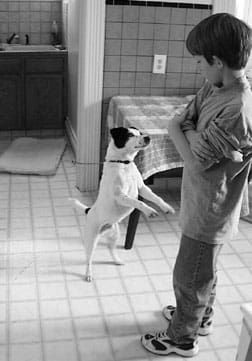If your dog gets too excited and jumps on strangers during walks, you’re not alone—and you’re not stuck with this problem. Teaching your dog polite greetings can make every walk more enjoyable and stress-free for you and everyone you meet.
Imagine turning those chaotic, jump-filled encounters into calm, friendly hellos that show off your dog’s best behavior. In this post, you’ll discover simple, effective steps to help your dog greet people politely without jumping. Keep reading, and you’ll soon enjoy peaceful walks where your dog impresses with good manners every time.
Choose The Right Walk Environment
Choosing the right walk place helps dogs learn polite greetings better. Quiet routes let dogs focus on meeting new people without many distractions. Avoid busy streets or parks where many people and dogs gather. Crowds can make dogs excited and jumpy.
Plan walks at times when fewer people are around. Early mornings or late afternoons work well. Less noise and fewer strangers make it easier for dogs to stay calm. This helps them greet nicely without jumping up.

Credit: mannersformutts.com
Prepare Your Dog Before Walks
Calm your dog before walks. Speak softly and gently pet them. This helps lower their excitement and stress levels. Deep breaths from you can also soothe your dog.
Practice basic commands like “sit,” “stay,” and “heel” daily. These commands help your dog listen better on walks. Reward with small treats or praise to encourage good behavior.
| Leash Type | Collar Type | Why Use It? |
|---|---|---|
| Standard leash (4-6 feet) | Flat collar | Gives control and comfort for everyday walks |
| Short leash | Martingale collar | Prevents pulling and slipping out |
| Hands-free leash | Harness | Good for jogging and reduces strain on dog’s neck |
Introduce Polite Greeting Behavior
Start by teaching your dog to sit and staywhen meeting new people. This helps your dog stay calm and focused. Use short commands and practice often in a quiet area. Reward your dog with treats or praise when they follow the command correctly.
Encourage a calm approachby letting your dog sniff and greet slowly. Give treats only when your dog stays calm near strangers. This teaches your dog that gentle behavior brings rewards.
Ignore jumping attempts. Turn away or step back if your dog tries to jump on someone. Do not give attention to jumping, as this can make the behavior worse. Wait for your dog to have four paws on the ground before giving any attention or treats.

Credit: www.whole-dog-journal.com
Handle Stranger Interactions
Let strangers know your dog is learning to greet politely. Ask them to avoid sudden movesand to keep their hands calm. This helps your dog stay calm and focused.
Encourage gentle petting only. Tell strangers to stroke softlyand avoid quick or loud actions. This teaches your dog to enjoy quiet, calm contact.
Unexpected excitement can happen. Stay calm and use a firm voiceto guide your dog. Keep a treat ready to reward calm behavior. This helps your dog learn to stay composed even with surprises.
Reinforce Training Consistently
Positive reinforcementhelps dogs learn polite greetings fast. Give treats or praise when your dog stays calm near strangers. This shows good behavior is rewarded. Use a happy voice and pet your dog gently to encourage them.
Practice regular walk drills by taking short walks focused only on greeting manners. Repeat these walks often to build good habits. Stop and ask your dog to sit before meeting new people. This keeps your dog focused and less likely to jump.
Track progress over time by noting how your dog reacts during each walk. Keep a simple log of successes and struggles. Celebrate small wins to stay motivated. Adjust your training plan based on what works best for your dog.

Credit: www.whole-dog-journal.com
Address Challenges And Setbacks
Patienceis key while teaching dogs polite greetings. Dogs may jump out of excitement or nervousness. Staying calmhelps them feel safe and learn better.
Change your method if the dog does not improve. Try shorter walksor more frequent breaks. Use gentle commandsand rewards to guide behavior.
Sometimes, professional trainers provide extra help. They teach special techniquesfor difficult cases. Seeking help early can make training easier and faster.
Frequently Asked Questions
How Can I Stop My Dog From Jumping On Strangers?
Teach your dog the “sit” command before greeting strangers. Reward calm behavior with treats and praise. Consistency during walks is key to reducing jumping habits.
Why Is Polite Greeting Important For Dogs On Walks?
Polite greetings prevent aggressive or anxious reactions. They promote positive socialization and safety for your dog and others. Proper greetings improve walk experiences and community interactions.
What Techniques Help Teach Polite Greetings To Dogs?
Use positive reinforcement like treats and calm praise. Practice controlled exposure to strangers during walks. Redirect jumping behavior with commands and consistent training sessions.
When Should I Start Training My Dog To Greet Politely?
Start training as early as possible, ideally during puppyhood. Early socialization helps establish good habits. However, adult dogs can learn polite greetings with patience and consistency.
Conclusion
Teaching your dog polite greetings helps make walks more pleasant. Practice calm behavior and reward your dog often. Keep training short and consistent for better results. Stay patient and positive during each walk. Polite greetings build good habits and strong bonds.
Enjoy peaceful walks with your well-mannered dog every day. Simple steps lead to great changes in your dog’s behavior. Keep trying, and success will follow.





